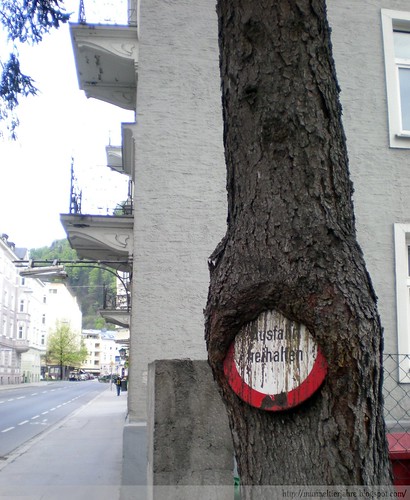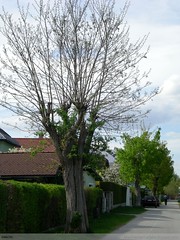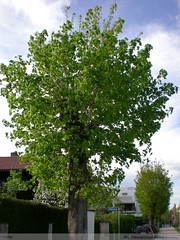Sometimes Nature surprises us with scenarios seemingly taken from a horror film, for instance this tree, which is taking revenge on those who hammered a traffic sign into it, slowly but without a rest...
I happen to meet another such scenario, not as horrific but still quite surprising, in my way by the river from the office to the bus stop. At the side there are some maple trees. Last year I realised that one of them has an elder on top of it, don't really know how. I was able to spot it because elderflowers are quite easy to recognise, because of the looks and the smell. "Strange", I thought, "how did this fellow manage to grow up there?"
These last weeks I am observing the maple with an elder, and I've seen something interesting. All other maple trees at the pathway already have lots of leaves, green and well formed. But the one with the elder on top has just started putting out little shoots, while the elder not only has all of its leaves fully formed, but also has sprouted the first elderflowers.

The maple with an elder (left) and a "normal" one (right). The latter has already lots of leaves, but on the former the only one with leaves on it is the elder!
That means, then, that the elder is, undoubtedly, a parasite of the maple tree. You'll never be too old to stop getting surprised...
Monday, 20 April 2009
Strange Nature
Subscribe to:
Post Comments (Atom)

 versión en español
versión en español







5 comments:
Ja die Natur laesst uns oft staunen.Dein Beitrag hat mich bewogen mal in meinem Garten etwas genauer hinzuschauen.An unserem Bachlauf stehen alte Weiden die alle paar Jahre geschnitten werden.Und Du wirst es nicht glauben,auf der einen waechst ein ca.30cm grosse Elder also eine Hollunderpflanze.Auf einer anderen hat sich ein grosser Bueschel Schoellkraut breit gemacht,und auf der Naechsten sass ein ganzer Wurzelstock Brennesseln,in ca 2m Hoehe.
Entweder vertragen die Samen solcher Schmarotzerpflanzen die Voegel oder aber der Wind.
Heisser Elderbeerensaft ist uebrigens gut bei Bronchitis,Brennesseln wirken Blut reinigend,und den gelben Saft des Schoellkrauts auf Warzen gestrichen,schaffen Abhilfe.
Schmarotzerpflanzen koennen so an den Wirtspflanzen zehren,dass diese sogar eingehen koennen.Oder aber erst viel spaeter ihr eigenes Wachstum entwickeln.Uebrigens Mispel setzten sich gerne in Ahorn oder Aepfelbaeumen fest,weil sie suesses Holz haben.Warum das so ist weiss ich nicht.LG.G
Zu dem "Ausfahrt Freihalten"Schild faellt mir nur Vergewaltigung ein.!
fuehlt sich fuer den Baum wahrscheinlich so an wie ein eingewachsenes Projektil bei einem Menschen :-()? LG.G
Gitta said...Yes, Nature astonishes us very often. Your post made me go out to my garden and take a closer look. We have some old willows near our stream. They are pruned every two years. And you won't believe it, but a some 30 centimetre elder grows on one of them. On another one there is a big bunch celandine and on the next one there is a nettle rootstock growing at a high of 2 metres.
The seeds of these parasite plants were probably carried by birds, or maybe the wind did it.
By the way, hot elderberry juice is good for bronchitis, nettle purges blood and the yellow juice of celandine smeared on warts produces relief.
Parasite plants can even kill the host plant or do not let it normally develop. By the way, medlar fixes itself in maple or apple trees because they have sweet wood. I don't know why! LG. GGitta said...To the "Ausfahrt freihalten" (keep clear) sign I can only think about rape! For the tree it feels probably as an ingrowing projectile in a human body :-(?Gitta, so it seems elders like to sit on other plants! I also think that birds are probably the ones who brought those elder seeds up there.
To the "Ausfahrt freihalten", I don't think someone did that to the tree. It seems to me that someone hammered the sign on the tree, some time ago, and since there the tree kept on growing around the sign. Like in the movie "Sleepy Hollow", in fact.
Liebe Grüsse
T.
Lieber Toni ich hab Dich schon richtig verstanden,ich finds trotzdem nicht richtig Naegel in "lebende" Baeume zu schlagen auch wenn es nur dazu dient ein Schild anzubringen.Wenn es nur gewoehnliches Metall ist, ummantelt es der Baum sobald er sein Wachstum fortsetzt.Siehe Deinen fotografierten Baum.Schlaegt aber jemand einen Kupfernagel in einen Baum, stirbt er von dem Abschnitt an wo der Nagel sitzt total ab.Warum genau kann ich Dir nicht sagen,Es hat aber mit den Stoffen die Kupfer aussendet zu tun.Vielleicht weiss ein Chemiker,oder aber ein Foerster darueber mehr.Ich weiss es von meinem Grossvater er war Holzfachmann.LG.G
Gitta said...Dear Toni, yes I did understand you right, but I don't think it is OK to hammer nails into living trees, even if it's just to hang a sign. If it is normal metal, the tree covers it with its growth (see your pictured tree). But if someone hammers a copper nail into a tree, it dies from the part where the nail is. I cannot tell you why, maybe it has to do with the substances that copper gives out. Maybe a chemist or a forester might know it. I know it from my grandfather, who was a wood professional.
LG. G
Gitta, I did not know that! But I know trees and plants in general are very complicated living chemical factories, so I can understand that messing up with an external element like copper may bring everything out of equilibrium.
LG. T.
Post a Comment